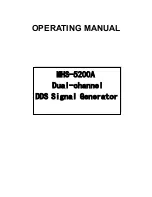
Host Programmer Model
Host Interface (HI08)
6
-23
6.7
Host Programmer Model
The HI08 provides a simple, high-speed interface to a host processor. To the host bus, the
HI08 appears to be eight byte-wide registers. Separate transmit and receive data paths are
double-buffered to allow the DSP core and host processor to transfer data efficiently at high
speed. The host can access the HI08 asynchronously using polling techniques or
interrupt-based techniques. The HI08 appears to the host processor as a memory-mapped
peripheral occupying eight bytes in the host processor address space. (See Table 6-14.)
The eight HI08 registers include the following:
n
A control register (ICR), on page 6-24
n
A status register (ISR), on page 6-27
n
Three data registers (RXH/TXH, RXM/TXM, and RXL/TXL), on page 6-30
n
Two vector registers (CVR and IVR), on page 6-26 and page 6-29
To transfer data between itself and the HI08, the host processor bus performs the following
steps:
1. Asserts the HI08 address and strobes to select the register to be read or written. (Chip
select in non-multiplexed mode, the address strobe in multiplexed mode.)
2. Selects the direction of the data transfer. If it is writing, the host processor places the data
on the bus. Otherwise, the HI08 places the data on the bus.
3. Strobes the data transfer.
Host processors can use standard host processor instructions (for example, byte move) and
addressing modes to communicate with the HI08 registers. The HI08 registers are aligned so
that 8-bit host processors can use 8-, 16-, or 24-bit load and store instructions for data
transfers. The HREQ/HTRQ and HACK/HRRQ handshake flags are provided for polled or
interrupt-driven data transfers with the host processor. Because of the speed of the DSP56303
interrupt response, most host microprocessors can load or store data at their maximum
programmed I/O instruction rate without testing the handshake flags for each transfer. If full
handshake is not needed, the host processor can treat the DSP56303 as a fast device, and data
can be transferred between the host processor and the DSP56303 at the fastest data rate of the
host processor.
One of the most innovative features of the host interface is the host command feature. With
this feature, the host processor can issue vectored interrupt requests to the DSP56303. The
host can select any of 128 DSP interrupt routines for execution by writing a vector address
register in the HI08. This flexibility allows the host processor to execute up to 128
pre-programmed functions inside the DSP56303. For example, the DSP56303 host interrupts
allow the host processor to read or write DSP registers (X, Y, or program memory locations),
Summary of Contents for DSP56303
Page 1: ...DSP56303 User s Manual 24 Bit Digital Signal Processor DSP56303UM AD Revision 1 January 2001 ...
Page 52: ...JTAG OnCE Interface 2 22 DSP56303 User s Manual ...
Page 114: ...General Purpose Input Output GPIO 5 10 DSP56303 User s Manual ...
Page 212: ...GPIO Signals and Registers 8 26 DSP56303 User s Manual ...
Page 268: ...Interrupt Equates A 22 DSP56303 User s Manual ...
Page 306: ...Programming Sheets B 38 DSP56303 User s Manual ...
Page 320: ...Index 14 DSP56303 User s Manual ...
















































